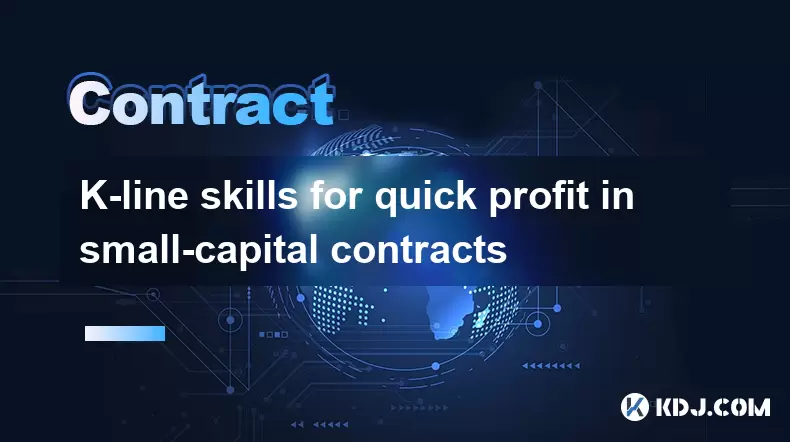-
 bitcoin
bitcoin $87959.907984 USD
1.34% -
 ethereum
ethereum $2920.497338 USD
3.04% -
 tether
tether $0.999775 USD
0.00% -
 xrp
xrp $2.237324 USD
8.12% -
 bnb
bnb $860.243768 USD
0.90% -
 solana
solana $138.089498 USD
5.43% -
 usd-coin
usd-coin $0.999807 USD
0.01% -
 tron
tron $0.272801 USD
-1.53% -
 dogecoin
dogecoin $0.150904 USD
2.96% -
 cardano
cardano $0.421635 USD
1.97% -
 hyperliquid
hyperliquid $32.152445 USD
2.23% -
 bitcoin-cash
bitcoin-cash $533.301069 USD
-1.94% -
 chainlink
chainlink $12.953417 USD
2.68% -
 unus-sed-leo
unus-sed-leo $9.535951 USD
0.73% -
 zcash
zcash $521.483386 USD
-2.87%
K-line skills for quick profit in small-capital contracts
K-line analysis in small-capital contracts can lead to quick profits by identifying patterns like Doji, Hammer, and Engulfing, and using them to trade breakouts with proper risk management.
Jun 07, 2025 at 07:49 pm

Introduction to K-line Analysis in Small-Capital Contracts
In the world of cryptocurrency trading, K-line analysis is a powerful tool that traders use to predict market trends and make informed decisions. Particularly in small-capital contracts, where the stakes are high and the markets can be volatile, mastering K-line skills can lead to quick profits. K-line charts, also known as candlestick charts, provide a visual representation of price movements over a specific period, making it easier for traders to spot trends and patterns.
Understanding K-line Basics
Before diving into advanced strategies, it's essential to understand the basics of K-line charts. Each K-line represents the price movement of a cryptocurrency within a specific timeframe. The body of the K-line shows the opening and closing prices, while the wicks or shadows indicate the highest and lowest prices during that period. A green K-line indicates that the closing price was higher than the opening price, suggesting a bullish trend. Conversely, a red K-line signifies a bearish trend, with the closing price lower than the opening price.
Identifying Key K-line Patterns
To achieve quick profits in small-capital contracts, traders must be adept at recognizing key K-line patterns. Some of the most common patterns include:
- Doji: A Doji occurs when the opening and closing prices are virtually the same, indicating market indecision. It can signal a potential reversal in the current trend.
- Hammer and Hanging Man: These patterns have small bodies and long lower wicks. A Hammer at the bottom of a downtrend suggests a bullish reversal, while a Hanging Man at the top of an uptrend indicates a bearish reversal.
- Engulfing Patterns: A bullish engulfing pattern occurs when a small red K-line is followed by a larger green K-line that completely engulfs it, signaling a potential upward trend. A bearish engulfing pattern is the opposite, suggesting a downward trend.
Utilizing K-line Patterns for Quick Profits
Once you can identify these patterns, the next step is to use them to your advantage in small-capital contracts. Here's how you can do it:
- Trade the Breakout: When you spot a bullish engulfing pattern, consider entering a long position. Place a stop-loss order just below the low of the engulfing candle to manage risk. For a bearish engulfing pattern, enter a short position with a stop-loss above the high of the candle.
- Confirm with Volume: Always confirm your K-line pattern with trading volume. A pattern accompanied by high volume is more likely to result in a significant price move, increasing your chances of quick profits.
- Combine with Other Indicators: While K-line patterns are powerful, combining them with other technical indicators such as the Relative Strength Index (RSI) or Moving Averages can enhance your trading strategy. For instance, if you see a bullish engulfing pattern and the RSI is below 30, it could be a strong buy signal.
Practical Example of K-line Trading in Small-Capital Contracts
To illustrate how K-line skills can lead to quick profits in small-capital contracts, let's walk through a hypothetical trading scenario:
- Spotting the Pattern: You're monitoring a small-capital contract and notice a Doji followed by a bullish engulfing pattern on the daily chart. The volume during the bullish engulfing candle is significantly higher than the average.
- Entering the Trade: You decide to enter a long position at the opening price of the next candle. To manage risk, you set a stop-loss order just below the low of the bullish engulfing candle.
- Setting the Target: Based on your analysis, you set a profit target at a previous resistance level, which is a reasonable distance from your entry point.
- Monitoring the Trade: As the price moves in your favor, you keep an eye on the K-line patterns and other indicators to decide whether to hold or take profits. If the price reaches your target, you close the position and secure your profit.
Risk Management in K-line Trading
While K-line skills can help you achieve quick profits, it's crucial to manage risk effectively. Here are some tips:
- Use Stop-Loss Orders: Always use stop-loss orders to limit potential losses. Place them at logical levels based on your analysis of the K-line patterns.
- Position Sizing: Never risk more than a small percentage of your trading capital on a single trade. This ensures that a series of losses won't significantly impact your overall account balance.
- Diversify: Don't put all your eggs in one basket. Consider trading multiple small-capital contracts to spread your risk.
FAQs
Q: Can K-line patterns be used effectively in all timeframes?A: Yes, K-line patterns can be used across various timeframes, from one-minute charts to daily charts. However, the reliability of these patterns may vary depending on the timeframe. Shorter timeframes can be more volatile and less reliable, while longer timeframes tend to offer more significant and reliable signals.
Q: How important is it to combine K-line analysis with other technical indicators?A: Combining K-line analysis with other technical indicators can significantly enhance your trading strategy. While K-line patterns provide valuable insights into market sentiment and potential reversals, other indicators like RSI, MACD, and Moving Averages can help confirm these signals and improve the accuracy of your trades.
Q: What are some common mistakes traders make when using K-line patterns?A: One common mistake is over-relying on K-line patterns without considering other factors such as volume and market context. Another mistake is not using proper risk management, such as failing to set stop-loss orders or risking too much capital on a single trade. Additionally, some traders may misinterpret patterns or fail to wait for confirmation, leading to premature entries or exits.
Q: How can I practice my K-line skills without risking real money?A: Many trading platforms offer demo accounts where you can practice trading with virtual money. This allows you to test your K-line skills and strategies in a risk-free environment. Additionally, you can use historical data to backtest your strategies and refine your approach before applying it to live markets.
Disclaimer:info@kdj.com
The information provided is not trading advice. kdj.com does not assume any responsibility for any investments made based on the information provided in this article. Cryptocurrencies are highly volatile and it is highly recommended that you invest with caution after thorough research!
If you believe that the content used on this website infringes your copyright, please contact us immediately (info@kdj.com) and we will delete it promptly.
- Missouri Man Accused in Horrific Execution of Child's Mother Over Coin Dispute
- 2025-12-23 06:50:01
- Big Three Bet Big: Binance, Solana, and Coinbase Chart a Course for Institutional Crypto Domination and Innovation
- 2025-12-23 09:55:01
- Cam Heyward Owns Coin Toss Blunder as Steelers Grab Crucial Win
- 2025-12-23 06:55:01
- Coinbase Charts New Course: Acquiring The Clearing Company for Event-Based Trading Dominance
- 2025-12-23 07:40:01
- Bitcoin's Quantum Conundrum: Navigating Safety in the Age of Advanced Computing
- 2025-12-23 09:55:01
- Coinbase Eyes "Everything Exchange" with Prediction Markets Acquisition of The Clearing Company
- 2025-12-23 07:00:02
Related knowledge

How to calculate profit and loss (PnL) in crypto futures?
Dec 23,2025 at 10:19am
Understanding Realized and Unrealized PnL1. Realized PnL is calculated only after a position is fully closed, using the difference between the entry p...

What is an initial margin in crypto futures?
Dec 23,2025 at 08:40am
Definition and Purpose of Initial Margin1. Initial margin is the minimum amount of collateral a trader must deposit to open a leveraged futures positi...

How Does the Liquidation Engine Work on a Crypto Exchange?
Dec 19,2025 at 05:59am
Core Mechanism of Margin Liquidation1. When a trader opens a leveraged position, the exchange assigns an initial margin requirement and a maintenance ...

Why is Risk-to-Reward Ratio Crucial in Futures Trading?
Dec 08,2025 at 01:20am
Risk-to-Reward Ratio Defined1. The risk-to-reward ratio quantifies the potential loss against the potential gain for a single futures trade. It is cal...

A Step-by-Step Guide on How to Short Bitcoin with Futures.
Dec 07,2025 at 06:39pm
Understanding Bitcoin Futures Contracts1. Bitcoin futures are standardized agreements to buy or sell BTC at a predetermined price and date in the futu...

Understanding the Relationship Between Leverage and Margin.
Dec 14,2025 at 02:39am
Core Mechanics of Leverage in Crypto Trading1. Leverage allows traders to control a larger position size than their available capital would normally p...

How to calculate profit and loss (PnL) in crypto futures?
Dec 23,2025 at 10:19am
Understanding Realized and Unrealized PnL1. Realized PnL is calculated only after a position is fully closed, using the difference between the entry p...

What is an initial margin in crypto futures?
Dec 23,2025 at 08:40am
Definition and Purpose of Initial Margin1. Initial margin is the minimum amount of collateral a trader must deposit to open a leveraged futures positi...

How Does the Liquidation Engine Work on a Crypto Exchange?
Dec 19,2025 at 05:59am
Core Mechanism of Margin Liquidation1. When a trader opens a leveraged position, the exchange assigns an initial margin requirement and a maintenance ...

Why is Risk-to-Reward Ratio Crucial in Futures Trading?
Dec 08,2025 at 01:20am
Risk-to-Reward Ratio Defined1. The risk-to-reward ratio quantifies the potential loss against the potential gain for a single futures trade. It is cal...

A Step-by-Step Guide on How to Short Bitcoin with Futures.
Dec 07,2025 at 06:39pm
Understanding Bitcoin Futures Contracts1. Bitcoin futures are standardized agreements to buy or sell BTC at a predetermined price and date in the futu...

Understanding the Relationship Between Leverage and Margin.
Dec 14,2025 at 02:39am
Core Mechanics of Leverage in Crypto Trading1. Leverage allows traders to control a larger position size than their available capital would normally p...
See all articles










































































